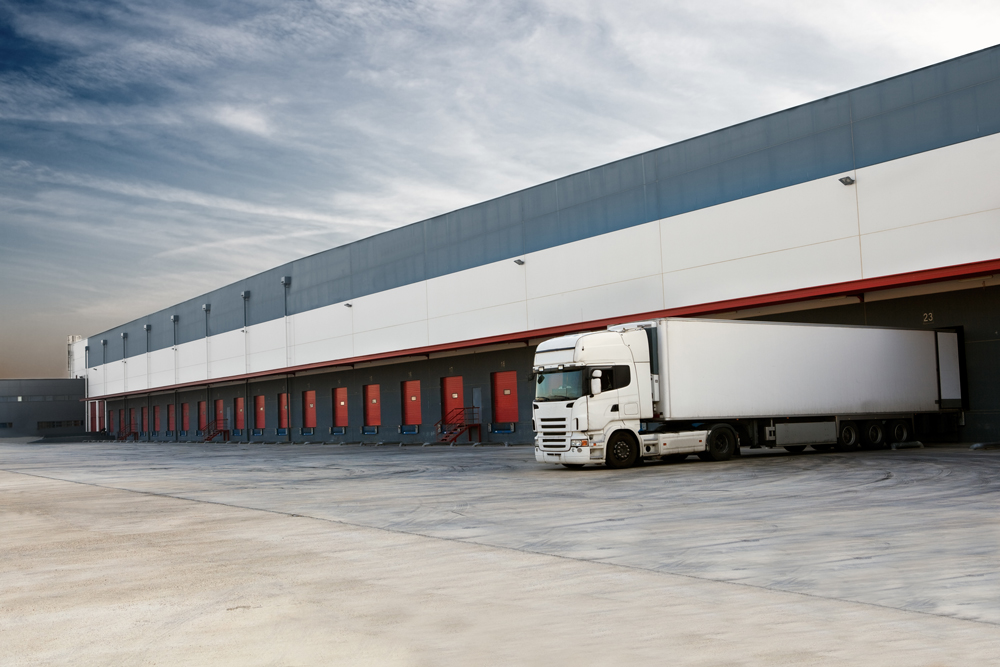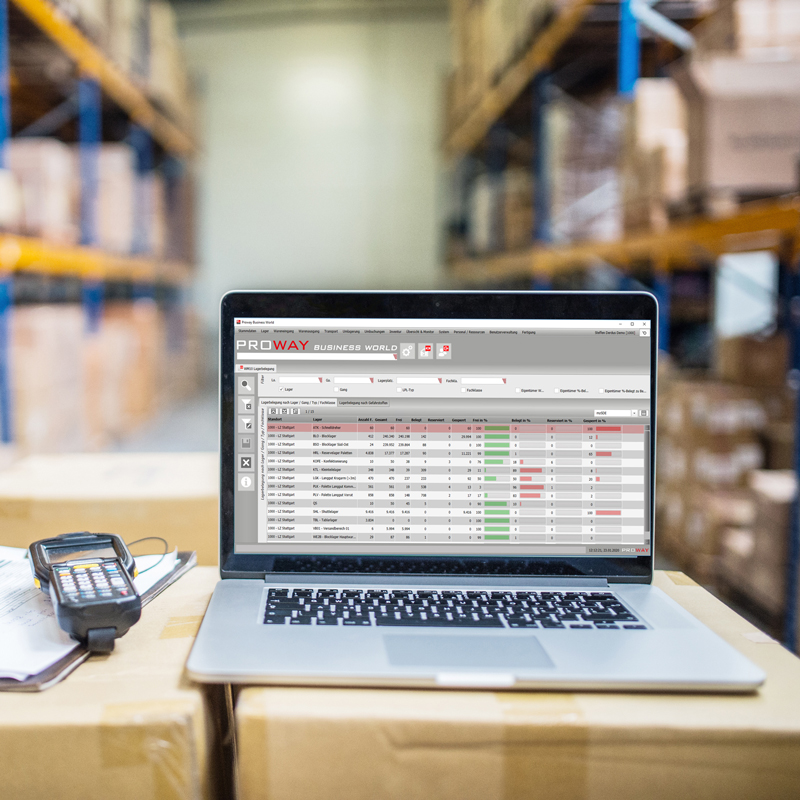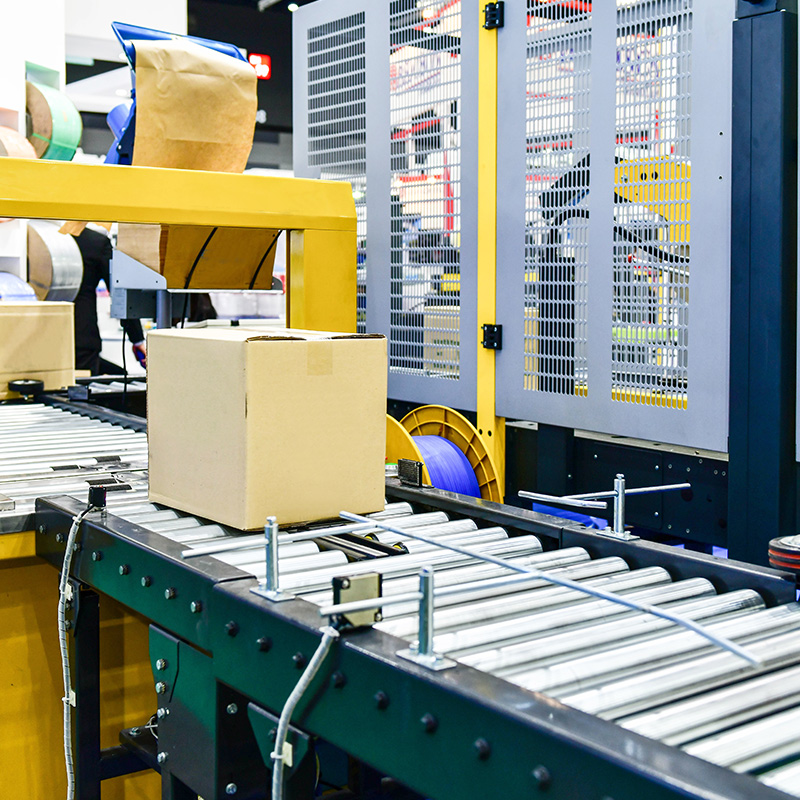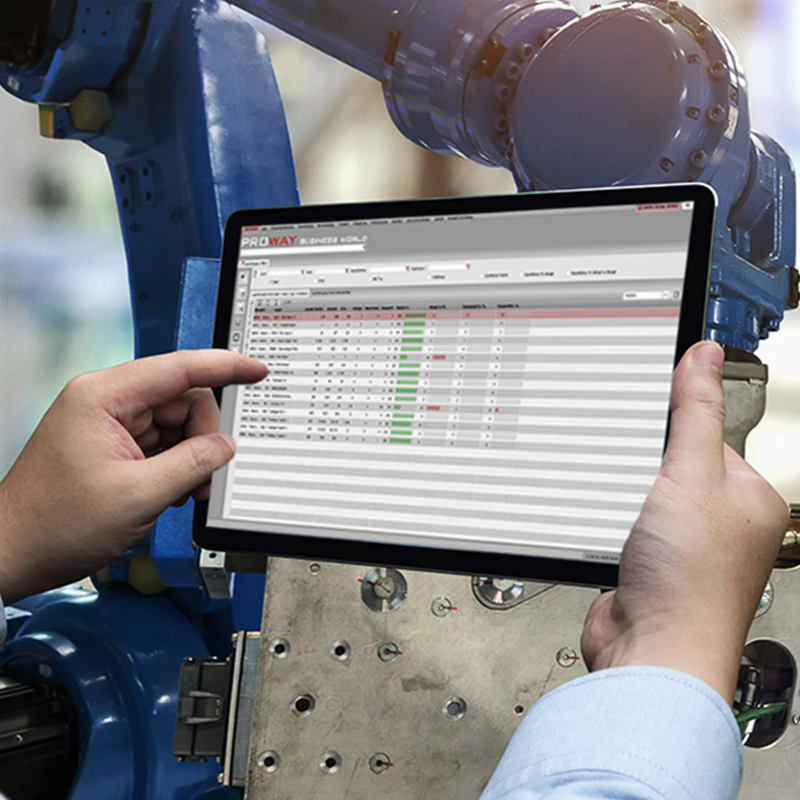Functions
The basis of PBW is the kernel which is used for all other modules and functions. All modules refer to this basic functionality. You can choose between several modules and functions to customise PBW to your intralogistics:
- Structure and Master Data
- Goods Receipt
- Goods Issue
- Inventory
- Warehouse Management
- Activity Based Costing
Further functions such as personnel and resource management as well as production control can be found in our function catalogue, please request here.

Structure and Master Data
The warehouse structure forms the basic framework of the logistics sites. All operational areas, from the storage areas with their storage locations to all process areas, are defined here. A large number of parameters are used to ensure the optimum flow of materials throughout the entire logistics process, from receipt to shipping.
- Creation and administration of warehouse areas
- Cross site
- Receiving areas
- Shipping areas
- Clarification areas
- Block storage
- Flow-through storage
- Shuttle system and automatic small parts warehouse
- Shelf warehouse
- Cantilever racks
- Automatic high-bay storage and tray storage
- Long goods storage facility
- Transport point assignments
- Bundling in warehouse area groups
- Aisle strategies for storage
- Replenishment strategies
- Display mode of barcodes and clearances of the storage bin
- Flexible lock management
- Creation and administration of locations
- Aisle and rack assignments
- Definition of dimensions
- Maximum weight per storage bin and bay load
- Maximum occupancy of storage bins
- Dynamic and flexible allocation options for the management of different load carriers at one place
- ABC classes
- Subdivision into storage zones
- Subdivision into fire zones
- Transport point management
- Creation of material master data
- Material master maintenance
- Dimensions and weights
- EAN Code
- Material groups and assortments
- Material types
- Hazardous materials und VCI classes
- Batch management
- Certificate duty
- Best before date and manufacturer date obligation
- ABC and XYZ classes
- Material photo
- Additional texts to the material
- Multilingual article texts and material-related text
- Storage and retrieval strategy
- Batch compliance checks
- ERP plants
- Serial number profiles
- Units and packaging hierarchy
- Site and warehouse assignments with minimum and maximum
- Fixed bins
- Consumption behaviour analysis
- Packaging material management
- Mass maintenance of material master data
- Bill of materials
- Administration and creation of customer master data
- Administration and creation of supplier master data
- Administration and creation of forwarder master data
- Management of empties accounts
Goods Receipt
The tasks of goods receiving are not only the control and collection of delivered goods. Intelligent storage strategies, cross-docking, assembly, QA, supplier ratings and returns management are fixed components of goods receipt in modern logistics.
- Manual creation of a goods receipt
- Transfer of a goods receipt order from an ERP system
- Confirmation of receipt to the ERP system
- After creation of the load carrier
- After storage of the load carrier
- After collection of a whole receipt order
- If necessary, manual control of the confirmation
- Management of goods receipt order types
- External receiving
- Internal receiving
- Returns
- Goods receipt from production
- Expandable as desired
- Forming article-specific load carriers
- Forming mixed load carriers
- Additional storage to existing load carriers
- Repack
- Checking dimensions
- Checking weights
- Display of material photos for better identification
- Simplified storage of pallet goods with quantity proposal
- Automated stock determination with assignment matrix and minimum or maximum quantities
- Management of load carrier number ranges
- Management of load carrier types and load classes
- Generate lists or labels for the load carrier and the stock id
- Management of returns
- Management of blocked stock
- Management of special stock, individual customer stock, consignment, project
- Management of certificate duty
- Best before date
- Manufacturer date
- Batch management
- Management of work instructions for goods receipt item and/or material
- Automatic scales
- Cross dock / Bypass
- Management of packaging hierarchies
- Management of partial deliveries, short delivery, over deliveries
- Goods receipt overviews with individual selectable filter criteria
- Even already archived data can be viewed
- Warehouse area identification to
- Receipt order types
- Differentiation according to article-specific and mixed pallets
- Packaging hierarchies
- Load carrier types
- Minimal or maximum quantities
- Minimum or maximum number of load carrier
- Owner
- Weight
- Special stock
- Aisle distribution
- Ascending
- According to utilization
- Uniform distribution of the material to all aisles
- Hold together properties of to one aisle (such as batch number or BBD)
- VCI classes and hazardous material
- Storage bin search
- Real-time search at the last transport point
- Best fit
- Automated search of alternative storage bins
- Manual allocation of storage bins
- Fixed storage bins
- Article-specific bulk storage
- Multiple depth storage
- Mixed storage of e.g. Euro or US pallets
- Check maximum weights of load carrier and storage bin / bay load
- ABC classes
- Consideration of blocking indicators
- VCI classes and hazardous material
- Check digits management


Goods Issue
In the goods issue area, the picking, packing and loading of the goods to be shipped is coordinated. Process plan templates are used to optimise the material flow and routes in the warehouse. Control centre tasks such as stock reservation and picking release can also be controlled automatically by PBW.
- Manual creation of a shipping order
- Transfer of a shipping order through an ERP system
- Possible confirmations to the ERP system
- Pick feedback after the pick or picking process
- Pack feedback of packaging data
- Loading confirmation of loaded pallets
- Shipping
- Cancellation
- Management of shipping order types such as
- Shipping order with supply
- Shipping order with loading
- Shipping order with packing and loading
- Transfer from one Logistic site to another
- Production supply
- Scrapping
- … and more
- Assignment of
- Process plan templates
- Priorities
- Tours
- Delivery types
- Forwarders
- Customers
- Time scales
- Loading
- Shipping
- Delivery
- Administration of
- Addresses
- Further texts for order header and item
- Additional logistic services, such as
- Band
- Stretch
- Repack
- Displays
- Individual expendable
- Order progress bar for viewing all process steps
- Graphical display of the process steps performed in percent
- Summarily stock reservation
- Manual by the user
- Automatically by the system according to freely selectable and combinable criteria
- Reservation of stock id and load carrier
- Determination of the source warehouse area according to warehouse sequences and packaging hierarchies (pcs, carton, pallet, etc.)
- Manual by the user
- Automatically by the system according to freely selectable and combinable criteria
- Shipping order type
- Customer order type
- Delivery type
- Material type
- Tour
- Priorities
- Shipping date and time
- Selection of the stock items:
- First in First out (FIFO)
- Last in First out (LIFO)
- First Expired First out (FEFO)
- Last Expired First out (LEFO)
- Minimize number of physical removals
- Maximize number of load carrier which become empty
- Direct hit
- Picking sequence
- Optimized routes
- By weight groups
- By volume groups
- Picking release
- Manual by the user
- Automatically by the system according to freely selectable and combinable criteria
- Shipping order type
- Customer order type
- Delivery type
- Material type
- Priorities
- Shipping date and time
- Picking release
- Pick release
- Resetting the reservation
- Resetting the picking release
- Shipping order cancellation
- Shipping order item cancellation
- Picking item cancellation
- Partial deliveries
- Short deliveries
- Replenishment strategy with definition of source warehouse areas
- Management of minimum and maximum quantities in the target warehouse area
- Storage area supply (chaotic storage)
- Fixed storage supply (fixed bin for material)
- Order-related replenishment
- Pick by light, to light, by voice, by view
- Pick and Pack
- By list
- By mobile device
- WEB based with e.g. mobile or tablet
- At a workstation
- With route-optimized sorting of picking items
- Express picking
- Management of picking instructions (material or order related)
- BBD
- Batch
- SSCC)
- Formation of handing units w/ or w/o packaging aids
- Combine picking items according to:
- Order
- Tour
- Warehouse area group
- Negative Picking
- Manually
- Automatic suggestion scheme from a defined threshold in per cent
- Shortage management with automated re-reservation
- Residue inventory from a defined treshold for quantity and / or values
- Bulk picking with free choice of the removal palette
- 2-stage picking with value added services, such as
- Band
- Stretch
- Re-palletizing
- Batch compliance checks
- Forming displays
- … and more
- Management of workstations in automated warehouses Automated transportation to consolidation, packaging or shipping areas
- Display of material photos for better identification
- Packing
- Unpacking
- Repacking
- Shortage handling with automatic post reservation
- Cancellation
- Volume and weight control
- Automated calculation of shipping boxes
- Administration of SSCC (NVE)
- Forming of transportable loading equipment
- Management of packing instructions (material or order related)
- Creation of packing lists
- Automated transportation to shipping areas
- Package overviews and work progress indicator
- Creation of loading lists
- Loading
- At a workstation
- With mobile devices
- Unload
- Optional truck registration
- Optional photo management of the loaded goods
- Manual Transfers (special authorization required)
- Loading overviews and work progress indicator
- In transit
- Ready to load
- Loaded
- Shortage analysis
- Check of the existing material stock
- Batch
- Best before date
- Stock category
- Assignment owner
- Assignment ERP plant und location
- Special stock
- Source warehouse area without permission for reservation
- Source warehouse area without permission for full-pallet transport
- Warehouse area, aisle, location restrictions
- Technical blocking in an automatic bearing
- Blocking of the stock id
- Current open Inventories
- Check of the existing material stock
- Order progress
- Order processing progress at order / picking level
- No picking release carried out
- Picking item not yet confirmed
- Picking item not yet packed
- Handling Unit for packed picking item not yet completed
- Handling Unit not yet transported to the shipping zone
- Handling Unit not yet loaded
- Order processing progress at order / picking level
- Overview packages
- Information about a package or the Serial Shipping Container Code (SSCC, NVE)
- Handling Unit
- Tour order
- Shipping order
- Materials
- Information about a package or the Serial Shipping Container Code (SSCC, NVE)
- Overview loading zones
- Listing of the loading zones and loading gates
- Included load carrier or handling units with respect to shipping order and material
- Overview Shipping order
- With individual selectable filters
- Listing of all shipping orders with:
- Order data
- Processing status
- Order header and item texts
- Addresses
- Information about order and picking item
- Even already archived data can be viewed
- Overview of shipping order process plan
- Display of the material flow per order
- Confirms of the individual process steps
- Assignment of process steps to employees
- Determination of the processing time for the order (including all process steps)
- Information about the order header and item and the used load carrier
- Document management
- View the documents associated with the order or tour
Inventory
PBW manages both annual and permanent inventories. The inventory progress and inventory differences can be monitored by numerous analysis tools.
- Permanent inventory
- Cycle Count (e.g. count per quarter)
- Annual inventory
- Empty space inventory
- Residue inventory
- By owner of the material
- By ERP plants and locations
- Simplified inventory in block storage
- Freely selectable number of inventory items per inventory run
- Administration of first and subsequent counts
- Inventory recording
- With mobile devices
- At a workstation in automatic bearings
- By list
- Optional message for differences in counting
- Inventory control
- Display number of deviations on level inventory run
- Detailed display of differences at item level (colour coded)
- Printout of a difference list
- Initiate recounts
- Completion of inventory runs
- Inventory summary
- With individual selectable filters
- Colour coding of deviations
- List of open inventories
- Number of load carriers not yet counted
- Number of stock ids not yet counted
- Number of already scheduled inventories
- Number of inventories in progress
- Number of already counted and completed inventories
- Inventory difference list
- Grouping freely selectable and combinable to
- Site
- Material
- Batch
- Owner
- Depending on the grouping, the cumulated differences are shown
- Grouping freely selectable and combinable to
- Inventory report for a given key date
- Inventory recalculation
- Inventory comparisons and differences analysis with an ERP system
- Inventory confirms to ERP systems


Warehouse Management
All internal transports, warehouse occupancy and stocks are displayed and monitored in overview dialogues. Reorganisations and optimisations within the warehouse can be carried out with just a few mouse clicks.
- Stock overview
- With individual selectable filters
- Approach on level site, warehouse area or stock id
- Display of
- Total quantity
- Reserved quantity
- Blocked quantity
- Quantity in transport
- Free available quantity
- Grouping by batch is possible
- All further information about the stock set in tables or list form
- Display of additional texts for the stock id
- Display of blocking reasons
- All Information about the load carrier
- Storage occupancy
- Graphic display with coloured background
- Grouping can be freely combined according to:
- Warehouse area
- Aisle
- Location type
- Load class (dimensions)
- Owner
- The number of locations is given as value and percent
- Empty
- Occupied
- Reserved
- Blocked
- Shelf overview
- Graphical top view on the shelf
- Different colour display of
- Empty locations
- Occupied locations
- Blocked locations
- Material types
- VCI classes and hazardous material types
- ABC classes
- Automatic restructuring of the warehouse in the optimizations mode
- Resolution of miss-allocations of the load class
- Resolution of miss-allocations of the ABC class
- Worklist in the warehouse
- Grouping can be freely combined according to:
- Site
- Warehouse area group
- Warehouse area
- Aisle
- Transport point
- Automatic bearing
- Display of the number of work to be done in the warehouse or work area
- Open receipt order items
- Open picking items
- Open packaging items
- Open transports to dispatch area
- Inventories
- Storage
- Relocations
- Retrievals
- Complaint management
- Assignment of customer and operator
- Escalation management
- Information management
- Inspection orders
- Inventory
- Grouping can be freely combined according to:
- Creation and administration of transport points
- Assignment of transport zones
- Maximum number of transport orders that can be assigned at the same time
- Assignment of workstations
- Assignment of subordinate controls (e.g. in an automatic bearing)
- Assignment of resources to the transport point
- Maximum load of load carriers
- Minimum and maximum weights
- Mobile devices or automatic bearings
- Assignment of functions to the transport point
- E.g. printing
- E.g. confirmation sending
- Assignment of load classes to the transport point
- Transport destination control based on inspection rules
- Order type
- Processing type
- Load carrier type
- Load class
- Handling type
- Material type
- Delivery type
- Creation and administration of a transport route matrix
- Graphical user interface with individual warehouse layout
- Display of
- Transport points
- Warehouse area descriptions
- Incoming routes
- Outgoing routes
- Active and inactive routes
- Information about the transport point as pop-up
- Transport points on the graphical user interface
- Moving, modifying or deleting
- Painting transport routes
- Assignement of transport zones
- Transport order Konfirmation
- Assignment of transport orders to
- Workstations
- Mobile devices
- Conveyor goals in an automatic bearing
- System proposal for the next transport (push principle)
- Alternative free choice of the next transport (pull principle)
- Resource change at defined transfer points
- Confirmation by scanning
- Confirmation by list
- Automatic confirmation by the system
- Assignment of transport orders to
- Transport Monitor (Admin)
- Complete transport manually (if necessary with destination input)
- Reset transport to last processing step
- Delete transport
- Release transport for further processing
- Transport overview
- With individual selectable filters
- Display of open transports
- Transport type
- Load carrier
- Status
- Starting point
- Actual point
- Next point
- Target point
- Assigned workstation
- Priority
- Display of the goods on the load carrier
- Manual rebooking (special authorization required)
- Change of owner on the stock id
- Best before date
- Stock id batch
- Special stock indicator
- Material number on stock id
- Stock category
- Lock indicators
- Registration of the block reason
- Measurements and weights
- Quantity correction with confirmation to ERP
Activity Based Costing ABC
The goal of ABC is to display the costs generated by a process, a service or a good. These costs are assigned to a service recipient via account assignments and cost centres and can also be billed if necessary.
- Configuration
- definition recipient of benefit
- definition activity type
- assignment of activity types to activity type groups
- definition of booking codes (journal)
- assignment of activity types to booking codes
- Process cost accounting
- definition of the customer system
- assignment of activity types to cost centre
- assignment of activity types to handling matrix
- assignment of recipient to process
- Finance and cost information
- Definition of cost centres
- Definition of accountings
- Assignment of von activity types to cost rate
- Fixed costs and special work
- Recording of fixed costs and the share of the costs
- Recording of special works and costs
- Accounting
- Billing to:
- Inventory costs
- Quantity-dependent costs
- Quantity-independent costs
- Time-dependent costs
- Billing to:





